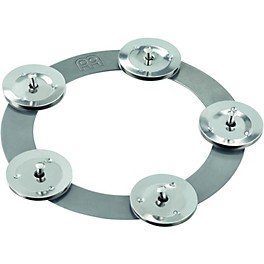Tambourines
Like many other hand percussion instruments, the tambourine traces its roots to the earliest of mankind's civilizations. In general terms, the tambourine comprises a series of loose jingles attached to a handle. The jingles, called zils, are often set in pairs, and produce high-pitch sounds. Some tambourines also feature a stretched skin to produce lower pitch sounds. Though it's referred to as an untuned instrument, certain design elements, like jingle size and handle material, impact the dominant frequencies produced. The tambourine is most often used to anchor rhythm, create a wash effect, or provide accents.
Many modern tambourines are constructed of high-impact plastics, that are designed to withstand repeated blows by a drum stick when mounted as part of a drum kit or percussion rig. These and other tambourines often incorporate an ergonomic handle that helps percussionists play for extended periods while experiencing less fatigue than standard handles. Whether mounted or played by hand, the tambourine is a familiar and welcome sound in most music genres.

